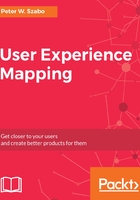
The narrative flow
How do the stories create a map? You simply need to arrange the cards. As we have seen in the previous chapter, by nature, people understand that a card above another card means a higher priority. Where the left-to-right writing pattern is dominant (most of the world, excluding Arabic and Hebrew and a few other written languages) if you put a card to the right of another card, people will understand that the story is told after the previous one in the flow. To reinforce this, some people add an arrow pointing to the left, but that's unnecessary. The user story represented by the card on the right of the first card is told after the first card, and so forth, while the rightmost story is told as the last. If possible, try to follow the natural order of events, as they happen with the user interacting with the product.
For example, a user story related to product search surely happens before the user story related to checkout, for example, entering your home address. Manually entering your home address and using an automatic address finder based on postcode seem to be part of the same story, but manually entering your home address is a critical, very important feature, while the postcode-based finder is a nice-to-have one. Therefore, you should add the postcode finder story below the manual entry story.